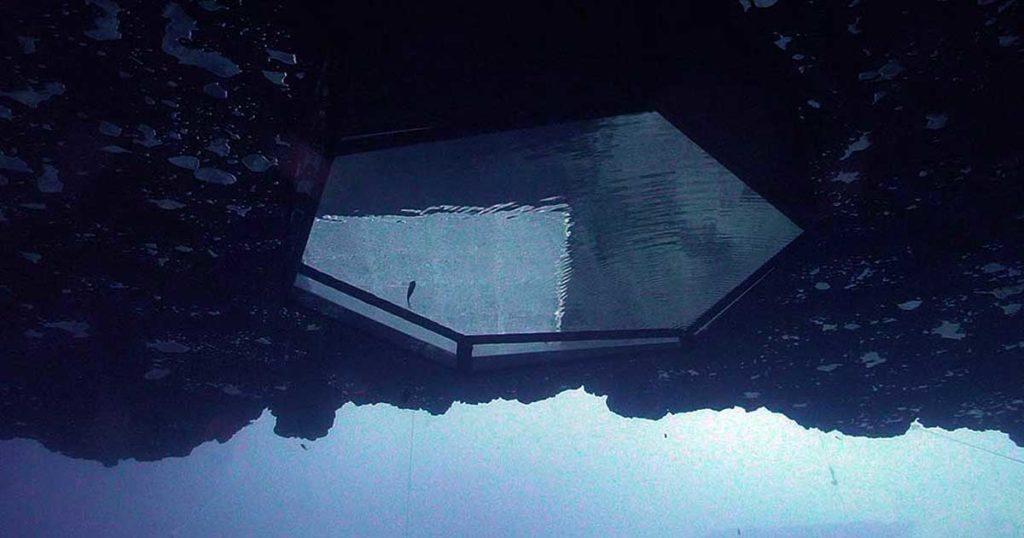Among Tom McQuarrie’s goals when opening Blue Grotto to the public in 1965 was making the site as safe as possible. Two steps he took to achieve this goal were installing the air bell and what Tom referred to as an “underwater chandelier.” Here is the story behind them.
The air bell
Blue Grotto was the first commercially operated cavern diving site in north-central Florida. At the time, diving a cavern that was safe for any certified diver was a relatively new idea. Tom wanted to ensure that divers could be comfortable and confident when doing so.
Tom figured that one of the things divers would find reassuring was not having to go all the way back to the surface to reach breathable air. At the time, there was no such thing as a submersible pressure gauge. Consequently, divers had no way of knowing how much air was left in their tanks. Running out of air was common.
Tom’s felt it might help to install an air bell at a depth of 30 feet. There was a problem, however, with doing so. If you’ve ever surfaced inside an air-filled chamber created by other divers’ exhaust bubbles, you know it does not smell very good. There are two issues here:
- The first of these is the concentration of oxygen. Exhaled air typically contains up to 25 percent less oxygen than normal atmospheric air. Then, if divers begin breathing air from the chamber, the oxygen levels can drop even further.
- The second issue is the concentration of carbon dioxide. This is the cause of the unpleasant smell. The more divers exhale into the chamber, the higher the concentration of CO2 becomes. High concentrations of CO2 can lead to a host of problems, including headache, nausea, dizziness and more.
Tom’s solution was to ensure the air bell was always filled with fresh air from the surface. Rather than run an unsightly hose down the wall of the Grotto, Tom had a local well driller create a hole from ground level straight down to the air bell. Through this, Tom ran an air hose leading from an electric compressor on the surface.
At the time, the local power company could not supply the three-phase power needed to run the type of compressor used to fill tanks. To compensate, Tom had a gasoline-powered compressor. This meant the air intake for the air bell compressor needed to be as far from the main compressor exhaust as possible.
Another challenge Tom faced was the fact there were no air bells available commercially. So, he built his own, using the metal from a large Coca-Cola sign for the ceiling and fashioning the walls from fiberglass.
Underwater, nothing lasts forever. Newer ones have long replaced the original air bell. It’s a process that continues as needed.
An underwater chandelier
Lack of SPGs was not the only challenge divers faced in the 1960s. Dive lights were large, bulky and not very reliable. They also output very little light. Backup lights as we know them today were nonexistent.
- During the day, a total light failure was not an issue. The abundance of daylight made it easy to find the cavern entrance. Night diving was a different matter.
- Today, streetlights, deck lights, and other illumination sources make it possible to locate the cavern entrance even without the sun to guide you. This was not the case in 1965.
Tom’s solution was to install what he called an “underwater chandelier.” This was the forerunner of the artificial light system you see today. This fixture contained multiple lights and was always on.
Tom’s idea was that if divers experienced a total light failure, they could swim to the chandelier. From here, they would see the air bell and, past it, the cavern entrance.
Installing the chandelier required drilling a second hole for the power cord. Like the one feeding the air bell, it’s still used today.
A different time
It’s important to understand just how different diving was a half-century ago.
- The difference between caverns and caves was not clearly defined. Even the term cavern diving did not come into common use until the 1970s.
- Equipment we now consider essential for safety, such as SPGs, simply wasn’t available.
- There were no other commercially operated cavern diving sites upon which Tom McQuarrie could pattern Blue Grotto. He was truly a pioneer.
The next time you visit the Grotto and see the air bell and lighting system, remember that you are looking at over 50 years of diving history. It’s a past worth remembering.
This is the third in a series of articles on the history of Blue Grotto. As before, we are indebted to Tom’s son, Tom McQuarrie, Jr., who documented these stories in Crystal River and Blue Grotto: The McQuarrie Chronicles. You can buy this book on Amazon using the link below.


